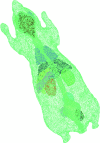Spectrally resolving and scattering-compensated x-ray luminescence/fluorescence computed tomography
- PMID: 21721815
- PMCID: PMC3133802
- DOI: 10.1117/1.3592499
Spectrally resolving and scattering-compensated x-ray luminescence/fluorescence computed tomography
Abstract
The nanophosphors, or other similar materials, emit near-infrared (NIR) light upon x-ray excitation. They were designed as optical probes for in vivo visualization and analysis of molecular and cellular targets, pathways, and responses. Based on the previous work on x-ray fluorescence computed tomography (XFCT) and x-ray luminescence computed tomography (XLCT), here we propose a spectrally-resolving and scattering-compensated x-ray luminescence/fluorescence computed tomography (SXLCT or SXFCT) approach to quantify a spatial distribution of nanophosphors (other similar materials or chemical elements) within a biological object. In this paper, the x-ray scattering is taken into account in the reconstruction algorithm. The NIR scattering is described in the diffusion approximation model. Then, x-ray excitations are applied with different spectra, and NIR signals are measured in a spectrally resolving fashion. Finally, a linear relationship is established between the nanophosphor distribution and measured NIR data using the finite element method and inverted using the compressive sensing technique. The numerical simulation results demonstrate the feasibility and merits of the proposed approach.
Figures






References
-
- Tian Y., Cao W.-H., Luo X.-X., and Fu Y., “Preparation and luminescence property of Gd2O2S:Tb X-ray nano-phosphors using the complex precipitation method,” J. Alloys. Compd. 433, 313–317 (2007).10.1016/j.jallcom.2006.06.075 - DOI
-
- Xing M., Cao W., Pang T., Ling X., and Chen N., “Preparation and characterization of monodisperse spherical particles of X-ray nanophosphors based on Gd2O2S:Tb,” Chin. Sci. Bull. 54, 2982–2986 (2009).10.1007/s11434-009-0492-9 - DOI
Publication types
MeSH terms
Substances
Grants and funding
LinkOut - more resources
Full Text Sources
Other Literature Sources
Medical
Miscellaneous

